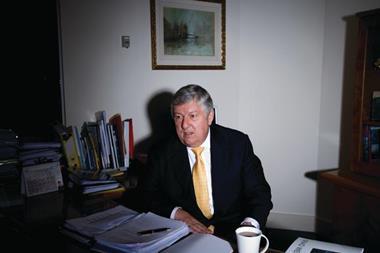With the Lloyd’s market slow to meet electronic targets and struggling to adapt to modern business etiquette James Dean asks if an institution so steeped in tradition can be successfully transformed?
Richard Ward has got his hands full. The chief executive of Lloyd’s spent last year fighting to implement electronic reform in the centuries-old marketplace and this year, he will be judged on the results.
But can an institution as steeped in history and tradition as Lloyd’s ever be truly transformed? Can starched brokers in braces who still look askance at women in the building be dragged kicking and screaming into the 21st century? Or do the antiquated outfits and puzzling customs simply form part of the market’s unique charm, attracting more customers than they repel?
Lloyd’s traditions are already set to be challenged with an influx of regional brokers likely to enter the market following the relaxation of accreditation laws (see box).
Last year the market consistently failed to meet its targets on take-up of the electronic claims filing system, with just 45% of claims going through the system at the end of the third quarter, compared to the 60% targeted.
Ward has repeatedly threatened to get tough with those missing the targets, but has yet to do so.
It is generally accepted that the market reforms are necessary. Ward neatly summed up the drivers for change in a speech last year: “We’re not efficient; our customers are expecting more; and we are faced with more competition. We cannot ignore these facts,” he said.
On the face of it, market reform centres on electronic claims processing and the use of the accounting and settlement repository to speed up the flow of cash.
But could the reluctance of some elements of the market to accept the new systems be part of a more deeply ingrained culture of resistance to change?
“Can starched brokers in braces who still look askance at women in the building be dragged kicking and screaming into the 21st century?
Mark Barwick, project manager at the London Insurance Market Brokers’ Committee (LMBC), insists that change can happen.
He said: “The can’t change wont change attitude is fast disappearing. It is being replaced by a willingness to try out new ways of working and new technology.”
Ward himself hinted that a relaxation of the stringent dress codes could be on the cards last summer – comments that were met with a predictable outcry. “It’s the beginning of the end. It’s nearly as bad as when they let women in,” one underwriter was reported to have said.
Prejudice aside, traditionalists argue that it is exactly these historical quirks and continuing traditions that give Lloyd’s its gravitas.
Bermuda and Dubai are all very well, the waiters in their red jackets seem to say, but have they a solid, respectable and utterly British 300-year history behind them?
The attraction of these traditions, and the respect they command, particularly overseas, cannot be underestimated.
Chairman of Tradex Tony Lumsden-Cook, who spent 52 years in the Lloyd’s market, said: “Lloyd’s traditions, especially dress code tradition, demonstrate a certain discipline. For example, an American who doesn’t wear a tie may wish to do business with someone who does – especially if there’s a lot of money involved.”
But how long can Lloyd’s be preserved in aspic if it is to achieve its goal of becoming a slick, sleek 21st century marketplace?
The Lloyd's rules
The rules for brokers wanting Lloyd’s
accreditation were relaxed last April, making it easier for regional brokers to move into the market. As well as dealing with the
antiquated etiquette, any broker must first:
• Sit in various pre-application meetings
• Submit an application form and £5,000 fee
• Wait a week for Lloyd’s to review it
• Submit detailed business plans
• Wait one to three weeks for Xchanging to review them.
If approved, it’s time to get broking. The basic system for placing a risk is:
• Find the relevant underwriter at the
relevant box
• Discuss the risk in detail
• Agree to get all or part of the risk
underwritten
• Add on considerable brokerage
• Get slip stamped and say thank you
• If necessary, repeat with other
underwriters until all the risk is written





































